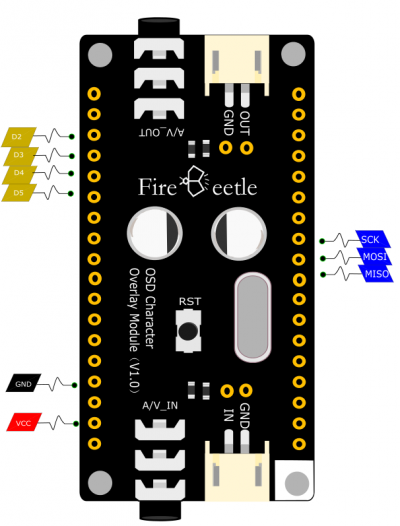Introduction
OSD is the abbreviation of On-screen Display, this is a screen menu adjustment display technology to add different menu-style characters on the screen display.
FireBeetle OSD Character Overlay Module is a new product presented by DFRobot. It adopts AT7456E OSD chip. This is a single-channel OSD module, equipped with functions like video drive, sync separator, video separate switch, etc. It comes with 512 bytes EEPROM user-defined storage space. After connected to video sources (AV Signals), the display covers 540x192 pixels which can show 16x30 characters on the screen. Users can also call font library to show characters and images.
This FireBeetle OSD Character Overlay Module is compatible with FireBeetle series interfaces and can be directly plugged into FireBeetle mainboards. This module can be widely applied to device character display and time display of monitor device such as road cameras, home automation.
Features
- 512-byte EEPROM user-defined storage space
- Support blink, inverse color and background control characters
- Support setting lightness line-by-line
- Maximum 16x30 characters display
- Support attenuation compensation of video drive output
- Built-in sync generator and support external compound sync signal input
- Compatible with NTSC and PAL
- Built-in characters stock
Specification
- Operating Voltage: 3.3V~5V
- Operating Current: 75mA
- Character Display: 16x30
- Character Pixel: 18x12
- Resolution: 540x192
- Color to Show: Single Color (White)
- Signal Source: AV I/O
- Communication Interface: SPI
- Operating Temperature: -10℃~85℃
- Dimension: 2.28in x 1.14in/58mm x 29mm
Function Diagram
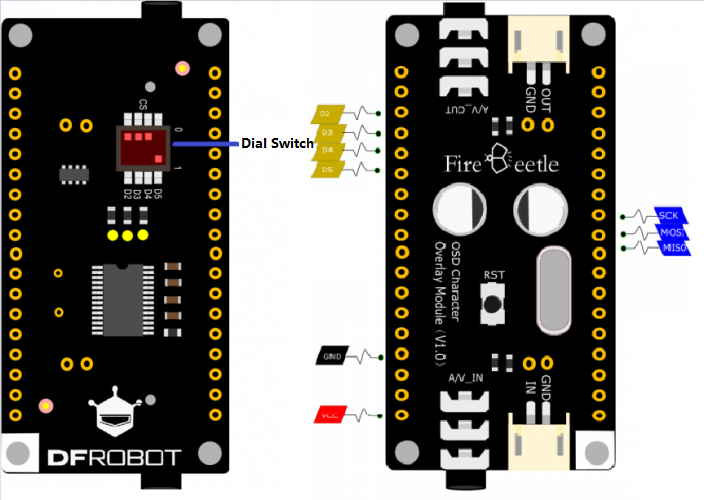
- Video Signal Input: RCA A/V_IN or PH2.0 IN
- Video Signal Input: RCA A/V_OUT or PH2.0 OUT
- OSD (On-screen Display) Control: SPI Interface
- RST: Reset button of OSD chip
- D2-D5: chip selection is available with dial switch
Board Overview
NOTE: When disconnect NC, VCC is the output voltage of the power supply(USB power supply: 5V; lithium battery power supply: 3.7V)
Tutorial
Requirements
-
Hardware
- AV Interface Camera x 1
- AV Interface Display x 1
- AV Signal Wire x 2
- OSD Character Overlay Module (V1.0) x 1
- FireBeetle-ESP32 x 1
-
Software
- Arduino IDE (Version requirements: V1.6.+), [https://www.arduino.cc/en/software| Click to Download Arduino IDE from Arduino®]
- Please click to download FireBeetle DFRobot_OSD Library. [https://docs.arduino.cc/software/ide-v1/tutorials/installing-libraries#.UxU8mdzF9H0| How to install Libraries in Arduino IDE]
- Matrix software TheDotFactory.exe is included in category tool of Arduino library, you can also download from github.
Connection Diagram
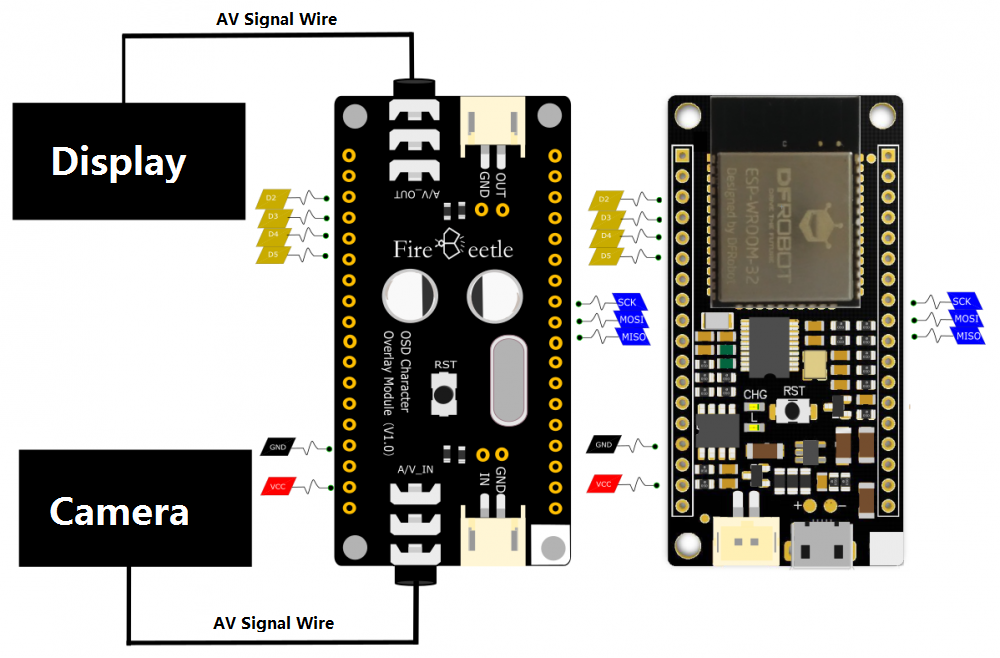
Operation Steps
- Connect OSD Character Overlay Module to FireBeetle-ESP32 according to the connection diagram and turn on the OSD dial switch (D3 at here).
- Connect camera and display to OSD Character Overlay Module according to the connection diagram.
- Connect FireBeetle-ESP32 to PC with USD wire and open Arduino IDE, download and run examples of DFRobot_OSD library.
NOTE: cs variable is chip select pin and it must be respond to dial switch. E.g. Dial switch D3 respond to IO26 of FireBeetle-ESP32. Here the CS is D3.
EEPROM Character Library
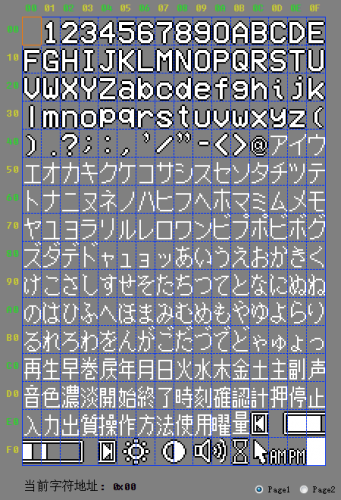
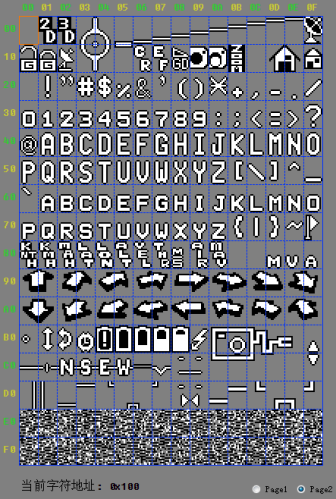
Matrix Software Guide
1. Click option button
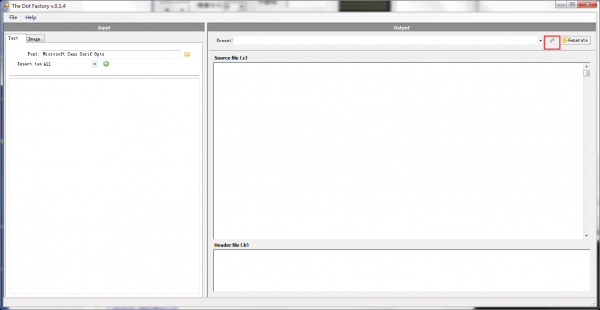
2. Select options as follows: Padding Removal, Line wrap,Byte
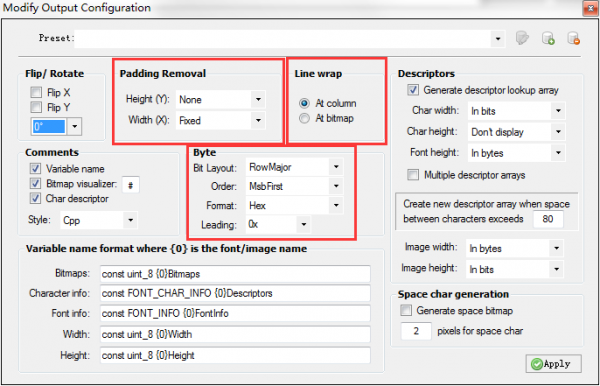
3. Input content to the left edit box, click Generate to get matrix.
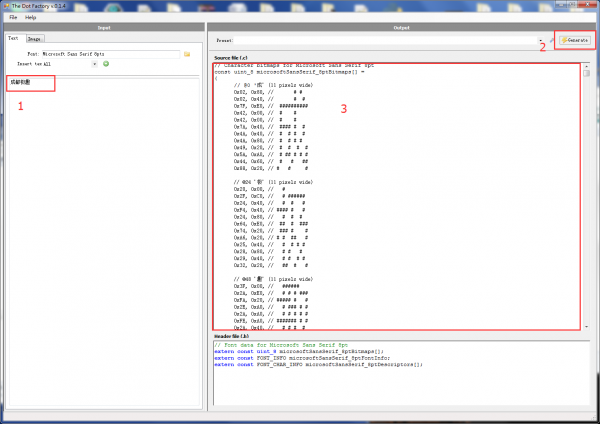
Sample Code
- Below is the FireBeetle DFRobot_OSD sample code. Please ensure CS is respond to CS pin.
/*!
* file DFRobot_OSD.ino
* character superimposition.
* @n This example Set characters on the screen.
*
* Copyright [DFRobot](https://www.dfrobot.com), 2016
* Copyright GNU Lesser General Public License
*
* version V1.0
* date 2017-10-9
*/
#include <DFRobot_OSD.h>
/*select CS pin*/
#ifdef __AVR__
int cs = 3;
#elif defined ESP_PLATFORM
int cs = D3;
#elif defined __ets__
int cs = D3;
#else
#error unknow board
#endif
DFRobot_OSD osd(cs);
/*Define Chinese characters*/
int buf0[36] = {0x00,0x00,0x40,0x01,0x40,0x02,0x40,0x03,0xFC,0x07,0x44,0x00,0x44,0x02,0x44,0x02,0x7C,0x02,0x94,0x02,0x94,0x01,0x92,0x01,0x12,0x01,0x9A,0x05,0x52,0x06,0x22,0x04,0x00,0x00,0x00,0x00};
int buf1[36] = {0x08,0x00,0x08,0x00,0xC8,0x07,0xBC,0x04,0xA8,0x02,0x98,0x02,0xFE,0x02,0x88,0x02,0x8C,0x02,0xB4,0x04,0xA6,0x04,0xBC,0x04,0xA4,0x04,0xA4,0x06,0xBC,0x00,0x84,0x00,0x00,0x00,0x00,0x00};
int buf2[36] = {0x00,0x00,0x04,0x02,0xC4,0x03,0x44,0x02,0x5E,0x01,0x44,0x01,0x44,0x05,0xCC,0x06,0x76,0x02,0x76,0x02,0xA6,0x02,0xA6,0x01,0x24,0x01,0x94,0x01,0x54,0x02,0x24,0x04,0x00,0x00,0x00,0x00};
int buf3[36] = {0x00,0x00,0x04,0x00,0xF4,0x01,0xAC,0x00,0xB4,0x07,0xA4,0x04,0xF4,0x05,0xAE,0x03,0xA4,0x02,0xE6,0x02,0xBA,0x06,0xE6,0x05,0xA6,0x01,0x86,0x00,0x89,0x00,0xF1,0x07,0x00,0x00,0x00,0x00};
void setup(){
osd.init();
osd.clear();
/* Write the custom character to the OSD, replacing the original character*/
/* Expand 0xe0 to 0x0e0, the high 8 bits indicate page number and the low 8 bits indicate the inpage address.*/
osd.storeChar(0xe0,buf0);
osd.storeChar(0xe1,buf1);
osd.storeChar(0xe2,buf2);
osd.storeChar(0xe3,buf3);
/*Displays custom characters*/
osd.displayChar(2,2,0xe0);
osd.displayChar(2,3,0xe1);
osd.displayChar(2,4,0xe2);
osd.displayChar(2,5,0xe3);
/*display character*/
osd.displayChar(9,9,0x11d);
osd.displayChar(9,10,0x11e);
osd.displayChar(8,11,0x10f);
/*display String*/
const char* str1 = "DFRobot";
String str2 = "2017.9.12";
osd.displayString(14,21,str1);
osd.displayString(2,19,str2);
osd.displayString(4,2,"hello world!");
}
void loop(){
}
Expected Results
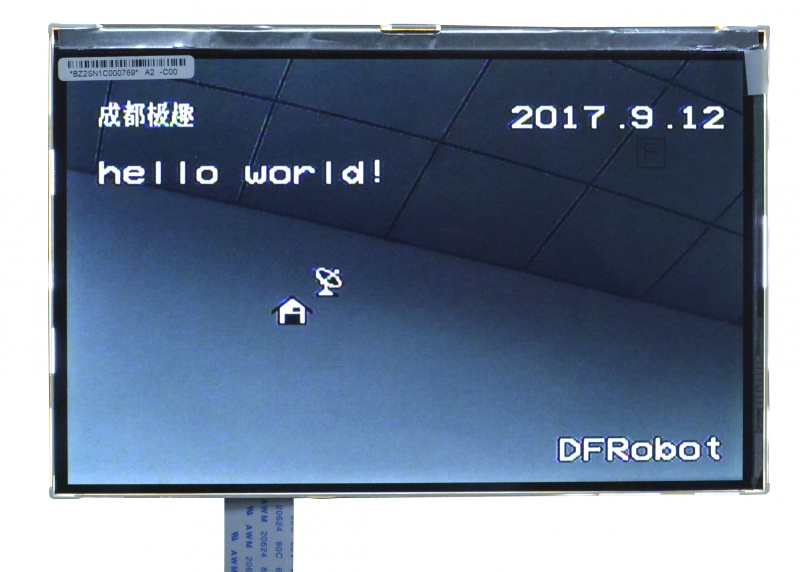
Compatibility Test
| MCU | Pass | Failed | Not Tested | Remark |
|---|---|---|---|---|
| FireBeetle-Board328P | √ | |||
| FireBeetle-ESP32 | √ | |||
| FireBeetle-ESP8266 | √ | |||
| Leonardo | √ | Tested with Dupont wire |
Arduino Library Functions
*Construct a function, parameter: CS(Chip Select) pins
DFRobot_OSD(int CS);
*Initialize OSD
void init();
*Clear characters in the display
void clear(void);
*Show EEPROM characters of 16x30. Parameters: row means Y-axis (0,15), col means X-axis (0,29), addr means characters address value, MSB is page number, LSB is page address (EEPROM for reference). E.g. 0x28, which means the first page and the page address is 0x28, refers to EEPROM and it stands for character-d; 0x10F, which means the second page and the page address is 0x0F, refers to EEPROM and it stands for character-radar.
void displayChar(unsigned char row, unsigned char col, unsigned short addr);
*Display strings, 16x30 characters utmost. Parameters: row means Y-axis (0,15), col means X-axis (0,29), s means string.
void displayString(unsigned char row, unsigned char col, unsigned char *s);
*Display strings, 16x30 characters utmost. Parameters: row means Y-axis (0,15), col means X-axis (0,29), s means string.
void displayString(unsigned char row, unsigned char col, String s);
*Save user-defined characters to OSD designated address. Parameters: addr means OSD address to save characters, dt is a matrix drawn by matrix software.
void storeChar(unsigned short addr,int dt[]);
FAQ
| Q&A | Some general Arduino Problems/FAQ/Tips |
|---|
For any questions, advice or cool ideas to share, please visit the DFRobot Forum.
Compatibility Testing
| MCU | PASS | Fall | None | Note |
|---|---|---|---|---|
| FireBeetle-Board328P | √ | |||
| FireBeetle-ESP32 | √ | |||
| FireBeetle-ESP8266 | √ | |||
| Leonardo | √ | wire connect |
Dimension
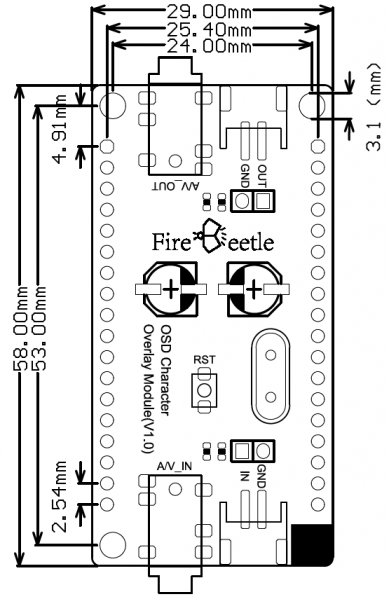
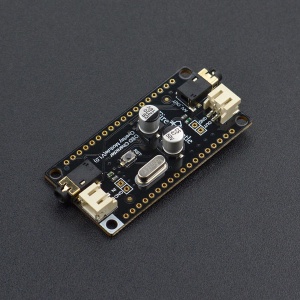](https://www.dfrobot.com/product-1700.html)
